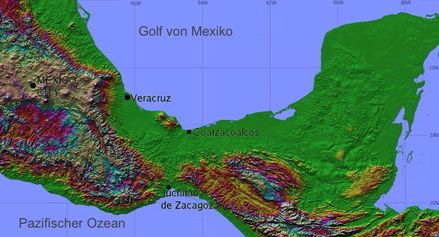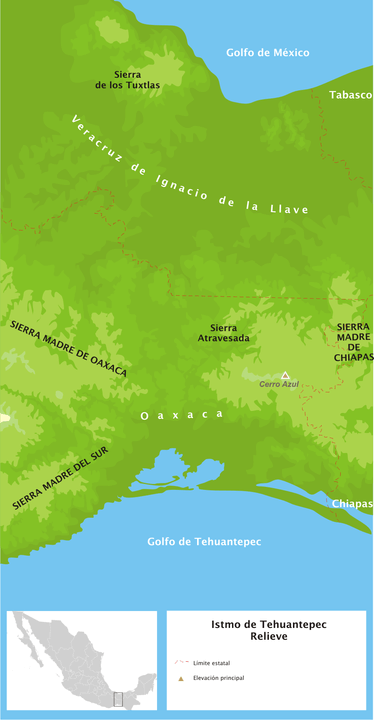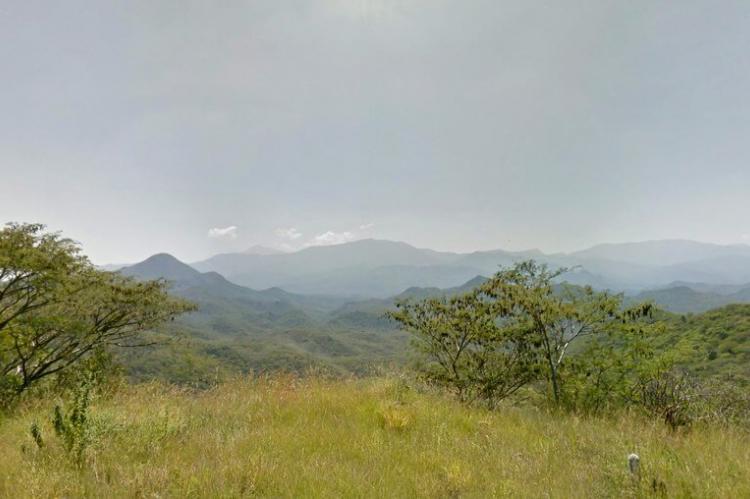Isthmus of Tehuantepec: Gulf of Tehuantepec (Mexico)
The Isthmus of Tehuantepec is an isthmus in southern Mexico between the Bay of Campeche and the Gulf of Mexico to the north and the Gulf of Tehuantepec on the Pacific Ocean to the south. It represents the shortest distance between the Gulf of Mexico and the Pacific Ocean.
Isthmus of Tehuantepec
The Isthmus of Tehuantepec is an isthmus in southern Mexico between the Bay of Campeche and the Gulf of Mexico to the north and the Gulf of Tehuantepec on the Pacific Ocean to the south. It represents the shortest distance between the Gulf of Mexico and the Pacific Ocean.
The Isthmus is approximately 220 km (137 mi) across at its narrowest point. The Sierra Madre breaks down at this point into a broad, plateau-like ridge. The northern side is swampy and densely covered with tropical forest; the Pacific slopes on the south are drier.
The population is composed almost wholly of indigenous Zapotec peoples. The women are the traders and do little menial work. Known as "Tehuanas," these women are known throughout Mexico for their colorful dresses, assertive personalities, and relatively equal relations with men, leading some to characterize them as "matriarchal."
Climate
The predominant climates in the region are tropical savanna (primarily in the south) and tropical monsoon (primarily in the north). There are also small central areas with a temperate climate due to elevation.
The narrowness of the Isthmus and the Sierra Madre gap allows the trade winds from the Gulf of Mexico to blow through to the Pacific. Usually, these winds are not particularly strong.
Periodically, however, a surge of denser air from the North American continent will send strong winds through the Chivela Pass and out over the Gulf of Tehuantepec on the Pacific coast. This wind is known as the Tehuano.
History
Before the opening of the Panama Canal, the Isthmus was a major shipping route known simply as the Tehuantepec Route. However, it was rejected as an interoceanic canal site because the canal construction would have been too costly.
Instead, since 1907, the Isthmus has been connected to Veracruz, Mexico City and the Guatemalan border by rail. The railroad, extending 192 miles (310 km) from Coatzacoalcos, on the Bay of Campeche, to Salina Cruz, on the Gulf of Tehuantepec, was opened in 1907.
The Tehuantepec railway (now the Ferrocarril Transístmico) or "Trans-Isthmic Railroad" also includes a branch of 29 km (18 mi) between Juile and San Juan Evangelista.

Relief map depicting the Isthmus of Tehuantepec
Gulf of Tehuantepec
The Gulf of Tehuantepec is an inlet of the Pacific Ocean in southern Mexico and forms the south shore of the Isthmus of Tehuantepec.
The widemouthed Gulf extends approximately 500 km (300 mi) from Puerto Angel southeastward to Barra del Suchiate and measures about 160 km (100 mi) across its mouth.
The Tehuantepec River and numerous smaller streams empty into the Gulf. The shores of the Gulf contain a series of lagoons, the largest of which are Superior, Inferior and Muerto. Laguna Superior marks the narrowest point of the Isthmus.
Salina Cruz is the Gulf's largest town and main port. It is also the endpoint of the Ferrocarril Transistmico railroad that crosses the Isthmus.

Relief map depicting the Isthmus and Gulf of Tehuantepec
